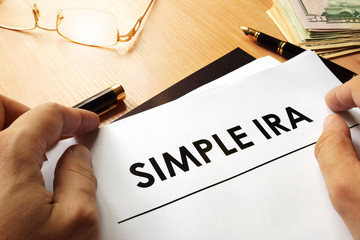SIMPLE IRA

Thinking about a retirement plan? If it seems like the right thing for your business, here’s a SIMPLE one.
A SIMPLE (Savings Incentive Match Plan for Employees of Small Employers) IRA plan offers great advantages for businesses that meet two basic criteria. First, your business must have 100 or fewer employees (who earned $5,000 or more during the preceding calendar year). In addition, you cannot currently have another retirement plan. If you are among the thousands of business owners eligible for a SIMPLE IRA plan, read on to learn more.
A SIMPLE IRA plan provides you and your employees with a simplified way to contribute toward retirement. It reduces taxes and, at the same time, attracts and retains quality employees. And compared to other types of retirement plans, SIMPLE IRA plans offer lower start-up and annual costs … they are just simpler to operate.
Other Advantages of a SIMPLE IRA plan
- SIMPLE IRA plans are easy to set up and run – your financial institution handles most of the details.
- Employees can contribute, on a tax-deferred basis, through convenient payroll deductions.
- You can choose either to match the employee contributions of those who decide to participate or to contribute a fixed percentage of each eligible employee’s pay.
- You may be eligible for a tax credit of up to $500 per year for each of the first 3 years for the cost of starting a SIMPLE IRA plan. (IRS Form 8881, Credit for Small Employer Pension Plan
Startup Costs). - Administrative costs are low.
- You are not required to file annual financial reports.
How does a SIMPLE IRA plan work?
Example 1:
Elizabeth works for the Rockland Quarry Company, a small business with 50 employees. Rockland has decided to establish a SIMPLE IRA plan for its employees and will match its employees’ contributions dollar-for-dollar up to 3% of each employee’s compensation. Under this option, if a Rockland employee does not contribute to his or her SIMPLE IRA, then that employee does not receive any matching employer contribution.
Elizabeth has a yearly compensation of $50,000 and contributes 5% of her compensation ($2,500) to her SIMPLE IRA. The Rockland matching contribution is $1,500 (3% of $50,000). Therefore, the total contribution to Elizabeth’s SIMPLE IRA that year is $4,000 (her $2,500 contribution plus Rockland’s $1,500 contribution). The financial institution holding Elizabeth’s SIMPLE IRA has several investment choices and she is free to choose which ones suit her best.
Example 2:
Austin works for the Skidmore Tire Company, a small business with 75 employees. Skidmore has a SIMPLE IRA plan for its employees and will make a 2% nonelective contribution for each of them. Under this option, even if a Skidmore employee does not contribute to his or her SIMPLE IRA, that employee would still receive an employer contribution to his or her SIMPLE IRA equal to 2% of compensation.
Austin’s annual compensation is $40,000. Even if Austin does not contribute this year, Skidmore must still make a contribution of $800 (2% of $40,000).
Pros and Cons:
- Easy and inexpensive to set up and operate
- Employees share responsibility for their retirement
- No discrimination testing required
- Inflexible contributions
- Lower contribution limits than some other retirement plans
- Who Contributes: Employer must contribute and employee may contribute.
Contribution Limits:
Total contributions to each employee’s SIMPLE IRA are limited.
Filing Requirements:
An employer generally has no filing requirements.
Participant Loans:
Not permitted. The assets may not be used as collateral.
In-Service Withdrawals:
Yes, but includible in income and subject to a 10% additional tax if under age 59-1/2. Also, if withdrawals are made within the first two years of participation, the 10% additional tax is increased to 25%.
Page Last Reviewed: 11/27/17
contact Vermillion Financial Advisors today.

